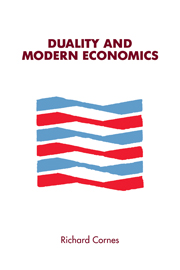Book contents
- Frontmatter
- Contents
- Preface
- PART I SOME BACKGROUND
- PART II MODELING INDIVIDUAL CONSUMER AND PRODUCER BEHAVIOR
- PART III APPLYING THE MODEL OF INDIVIDUAL BEHAVIOR
- Chapter 8 Aggregation analysis
- Chapter 9 Consumer theory and welfare evaluation
- Chapter 10 Externalities and public goods
- Epilogue
- Bibliography
- Author index
- Subject index
Chapter 8 - Aggregation analysis
Published online by Cambridge University Press: 11 September 2009
- Frontmatter
- Contents
- Preface
- PART I SOME BACKGROUND
- PART II MODELING INDIVIDUAL CONSUMER AND PRODUCER BEHAVIOR
- PART III APPLYING THE MODEL OF INDIVIDUAL BEHAVIOR
- Chapter 8 Aggregation analysis
- Chapter 9 Consumer theory and welfare evaluation
- Chapter 10 Externalities and public goods
- Epilogue
- Bibliography
- Author index
- Subject index
Summary
For certain purposes, the economist can enjoy the luxury of working at a very disaggregated level. For example, analyses of the conditions under which a competitive equilibrium is guaranteed to exist follow similar lines whether there are two commodities or 2 million. This being so, it makes good sense to accommodate the possibility of a large number of commodities. As with commodities, so with agents. Indeed, it can be a positive advantage to assume a large number of agents with different preferences. Local nonconvexities in the preferences of some particular group may then get washed out at the aggregate level.
Nevertheless, when it comes to qualitative comparative statics and empirical analysis of data sets, aggregation over things and people often is extremely helpful. It is therefore important to know whether, and under what assumptions, such aggregation is legitimate and also to know what useful properties, if any, of the disaggregated system survive the aggregation process.
Those who like neat, simple answers, and who would like to be able to believe that aggregated systems possess simple properties, will derive little comfort from aggregation analysis. The assumptions required to justify aggregation are quite stringent and are almost never satisfied in the world that generates the data.
- Type
- Chapter
- Information
- Duality and Modern Economics , pp. 189 - 203Publisher: Cambridge University PressPrint publication year: 1992



